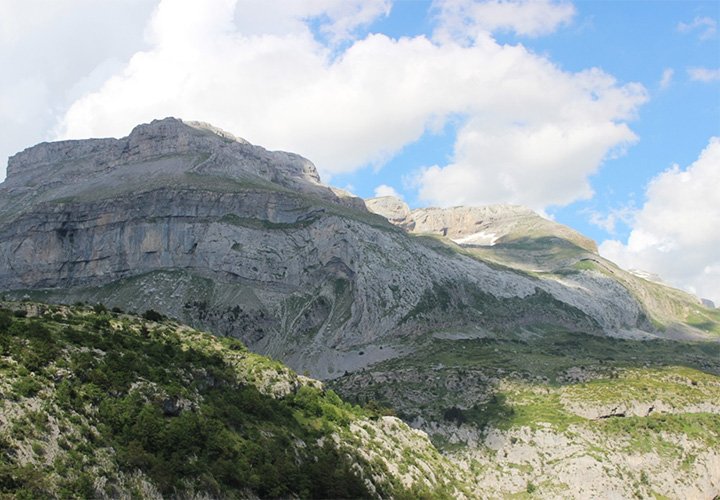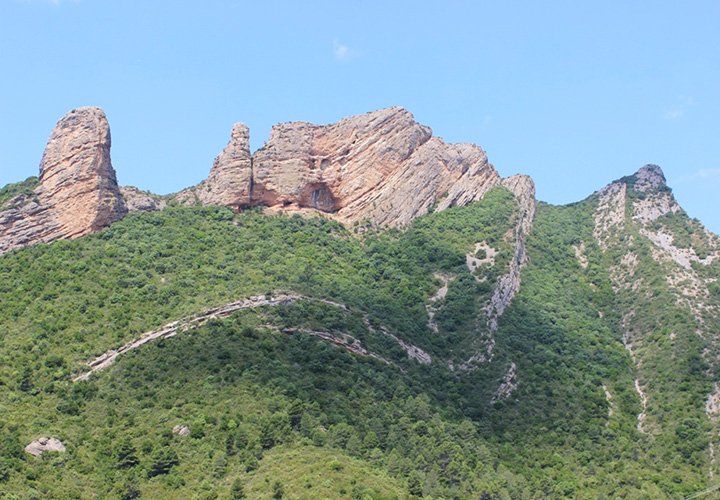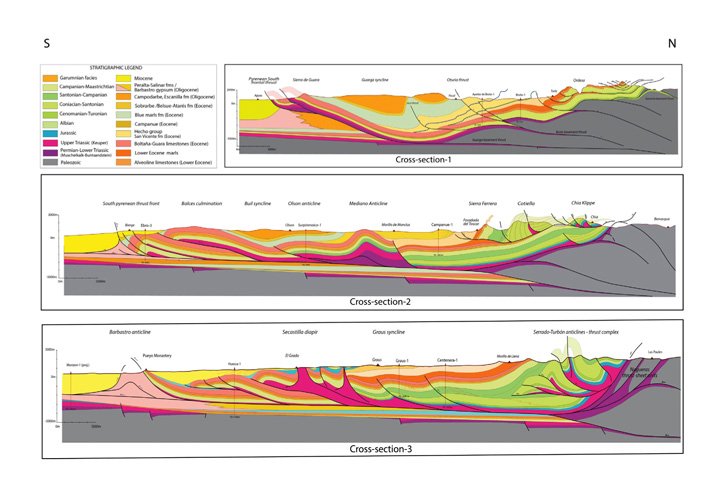FOLDS & THRUST BELTS (SOUTHERN PYRENEES, SPAIN)
How to understand compressive tectonic concepts, whilst visiting outstanding world class outcrops
- Course Type
Field Course - Duration
5 days - Thematic
Geosciences - Location
- Country
SPAIN -
Satisfaction rate

Why should you attend?
This course will allow the participants to see in cross section and in three-dimensional view outcrops the basic concepts of fold and thrust tectonics. Several sequences of thrust propagation with their relative timing and the detailed geometry of thrusts and their related folds.
The attendees will see multiple examples of compressional structures that can be analogs or examples for exploration and production case studies.
This course will help participants to feel more comfortable interpreting seismic in compressional, fold and thrust belt settings or to perform geological mapping of those areas.
The course will teach how to integrated outcrop geological information with seismic and well log data to construct a regional cross section through a fold and thrust belt.
Main Objectives:
The objective of this field course is to cover fold and thrust tectonics concepts that geologists and geophysicists need to carry out exploration or development in fold and thrust belt regions. Participants will have the chance to see, work and understand thrust structures, their detailed geometry, the growth strata associated and their relative timing.
This course offers the opportunity to see at least two complete cross sections through a folded belt from the hinterland to the foreland, in this case the Pyrenees, with continuous high-quality outcrops, well logs and seismic information.
The course covers thrust geometry and related folding, thrust timing and kinematics from outcrop scale to regional plate tectonics scale and stratigraphic units related to fold and thrust emplacement (i.e. pre-syn and post growth strata).
On completion of this course participants will
- Understand basic thrust tectonics and fold and thrust belt concepts.
- Identify rear and forward propagation sequences of thrusting.
- Understand thrust geometry in map and cross section view.
- Understand thrust geometries to help them interpret seismic in fold and thrust belt settings or perform geological mapping.
- •Identify pre, syn and post kinematic units and their related strata, especially growth strata packages, their timing.
- Integrate field outcrop observations with well logs and seismic data to construct a large scale regional cross section.
Learning Approach:
The course combines field observations, work and exercises on the field with seismic interpretation examples similar to those seen in the field at the end of each day. Class-room sessions include short lectures and seismic interpretation exercises. Lectures include presentation structural geology concepts, folded belt classification, the Pyrenees folded belt comparison with other folded belts worldwide.
The course is organized in such a way that what is learn in the field is then reviewed in the class-room. Additionally, seismic exercises on the same topics seen on the field will be reviewed and discussed in the class at the end of each day.
If the attendees have very diverse and different background a personalized explanation will be addressed to each group to maximize their understanding and learning.
HSE requirements:
Participants will be asked to wear reflecting jackets when next to a road cut and hard hat eventually in some selected but non dangerous outcrops. Some health information related to physical condition, medications and allergies will be requested to each participant, as well as emergency contact. This field course requires minor hiking so a fair physical condition is required.
Course Agenda:
Ideally this course takes five days. The length and content of the course could be modified based on specific needs.
Day 1: Lleida-Ainsa
- Brief introduction to the Pyrenees
- Ebro Basin Foreland
- Structure of the Sierras Marginales, cross section at the contact with the foreland basin.
- Structure of the Graus -Tremp piggy back basin.
- Structure of the deformed passive margin units.
- Class-room session, Introduction to the Pyrenees, review of the day observations.
Day 2: Ainsa-Monte Perdido National Park
- Structure of the deformed passive margin section, South Central Pyrenean unit
- Tectonic window at the contact of the Gavarnie and Monte Perdido thrusts sheets.
- Structure of the northern Monte Perdido thrust sheet
- Class room session. Review of the day observations, exercises on detachment and decollement systems in fold and thrust belts.
Day 3: Ainsa-Jaca
- Structure of the southern or frontal Monte Perdido Thrust sheet.
- Observation of Duplex and complex folding.
- Structure of folds and thrusts in turbiditic sequences, detachment folding and flexural slip, relationship to fractures.
- Class room session, integration of well logs and seismic data with field observations to construct a regional cross section.
Day 4: Jaca-Aragüés del Puerto
- Structure of the deformed passive margin units of the Jaca unit
- Observation of ramp and flat geometries.
- Fold geometry associated to thrusting
- Sequence of emplacement and thrust kinematics
- Classroom session seismic interpretation of thrust styles
Day 5 : Jaca-Huesca
- Structure of the deformed passive margin units of the Jaca unit
- Growth strata on Oligocene conglomerates
- Sierras Marginales north of Huesca, growth strata and detachment rotation
- Sequence of emplacement and thrust kinematics
- End of the field trip.
Author's References
- J. F. Flinch and J. M. Casas 1996. Inversion of a transfer system into lateral ramps: an example from the south-central Pyrenees (Spain). Geologische Rundschau 85 (2): 372-379.
- Camara, P. and Flinch J. F., 2017. The Southern Pyrenees: a salt-based fold and thrust belt. In, Soto, J. I, Flinch, J. F. and G. Tari (Editors): Permo-Triassic Salt Provinces of Europe, North Africa and the Atlantic Margins. p. 395 – 413. Elsevier http://dx.doi.org/10.1016/B978-0-12-809417-4.00020-3.
- Soto, J. I, Flinch, J. F., and Tari, G. 2017. Permo-Triassic basins and tectonics in Europe, North Africa and the Atlantic margins: a synthesis. In, Soto, J. I, Flinch, J. F. and G. Tari (Editors): Permo-Triassic Salt Provinces of Europe, North Africa and the Atlantic Margins. p. 4-32. Elsevier http://dx.doi.org/10.1016/B978-0-12-809417-4.00020-3

Prerequisites
Lecturers
-
 Dr. FLINCH J.Joan F. Flinch is currently an Independent Consultant and Senior Geoscience Consultant for Elsevier based in Madrid, Spain. Joan received his B. S. and M.S. degrees from the University of Barcelona, Spain in 1988 and 1990 respectively. His M.S. thesis focused on the structural mapping of the southern Pyrenees. He enrolled in the Geology and Geophysics Department at Rice University, receiving his Ph.D. in 1994, directed by Professor A. W. Bally. Before becoming an Independent Consultant, he spent 17 years at Repsol where he held the positions of West Africa New Ventures and Asset Manager, Latin America New Ventures Manager, Geology Manager, Geoscience Discipline Manager and Exploration Quality Advisor. He worked from 1997 to 2004 for Total, in Paris and Pau, France. From 1994 to 1997 he was a consultant geologist for Lagoven (PDVSA Affiliate) in Caracas. Joan has given numerous talks and published papers on the Pyrenees and the Betic Cordillera in Spain, the Moroccan Rif, the Northern Colombia Accretionary Prism, the Eastern Venezuelan fold-and-thrust belt, the Gulf of Paria, the Bolivia Sub-Andean region and the Sierra Leone-Liberia continental margin. He has been teaching several courses on Seismic interpretation and deep-water plays and leading geological field trips.
Dr. FLINCH J.Joan F. Flinch is currently an Independent Consultant and Senior Geoscience Consultant for Elsevier based in Madrid, Spain. Joan received his B. S. and M.S. degrees from the University of Barcelona, Spain in 1988 and 1990 respectively. His M.S. thesis focused on the structural mapping of the southern Pyrenees. He enrolled in the Geology and Geophysics Department at Rice University, receiving his Ph.D. in 1994, directed by Professor A. W. Bally. Before becoming an Independent Consultant, he spent 17 years at Repsol where he held the positions of West Africa New Ventures and Asset Manager, Latin America New Ventures Manager, Geology Manager, Geoscience Discipline Manager and Exploration Quality Advisor. He worked from 1997 to 2004 for Total, in Paris and Pau, France. From 1994 to 1997 he was a consultant geologist for Lagoven (PDVSA Affiliate) in Caracas. Joan has given numerous talks and published papers on the Pyrenees and the Betic Cordillera in Spain, the Moroccan Rif, the Northern Colombia Accretionary Prism, the Eastern Venezuelan fold-and-thrust belt, the Gulf of Paria, the Bolivia Sub-Andean region and the Sierra Leone-Liberia continental margin. He has been teaching several courses on Seismic interpretation and deep-water plays and leading geological field trips.


